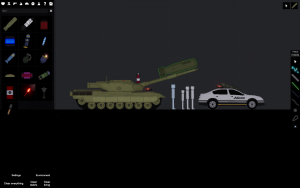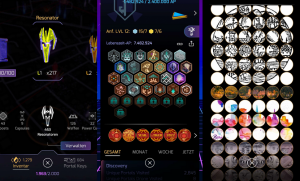Asteroids is a 2D science fiction space combat game released in 1979, over 44 years ago, by US based developer Atari. It was originally meant to run on arcade machines but was later even more popular as it was ported to one of the first programmable game consoles ever build by the same company named Atari 2600. With the 6-month birthday of this website coming up shortly we are going to celebrate by taking a look at exactly these origins and first steps of video games, with small reviews and history lessons in the next few weeks.
Pioneers of their time
Atari is one of the most iconic names in the history of video games. Founded in 1972 by Nolan Bushnell and Ted Dabney in Sunnyvale, California the company pioneered the arcade game industry like no other with selling hits like Pong, Breakout, Lunar Lander and many more. One of the most successful and influential games Atari ever produced is the classical space themed shooter Asteroids that was released in 1979 and sold over 70.000 arcade cabinets worldwide putting it in the top 5 list of all arcade games.
Birth of an idea
Lyle Rains Ataris vice president of engineering and Ed Logg, a game designer who had previously worked on Breakout, came up with the idea for Asteroids during a meeting and developed the concept based on another unfinished Atari game called Cosmos. Further inspirations were taken from the hit game Space Invaders from Japan and one of the first video games ever, named Spacewar! that ran on a PDP-1 Computer the size of a room and was developed in 1962. Logg then refined the game design through trial and error, adding more features such as hyperspace, the UFOs and the splitting of asteroids (all of which will be described more closely in a second). The game was then finally released in 1979 and ported to the Atari 2600 in 1981.
Visual Appearance and Gameplay of Asteroids
Probably everyone has once seen the gameplay of this legendary piece of computer history but here is a quick run-down: In the black and white video game the player is able to control a triangle spaceship which is originally located in the middle of the screen. After pressing start the player is confronted with asteroids flying randomly through the screen. By shooting these asteroids with the help of projectiles coming out the front of the spaceship the player can earn points and the asteroids get smaller by splitting up until they vanish completely. If the spaceship is hit by an asteroid it looses one life out of three so one needs to be careful.
Maneuverabilty of the Spaceship
You are also able to maneuver inside the space by turning the spaceship left and right and pressing the forward button to fire the thrusters which will accelerate the ship in the turned direction. The spaceship will then keep moving into this direction unless it is turned and the thrusters are fired in the opposite direction. Should you be in an emergency situation with an asteroid straight on collision course you can also press the hyperspace button spawning the ship on a random location on the screen which is also not without its own dangers as you could rematerialize directly above a meteoroid or even fail to rematerialize at all.
Furthermore there are also other dangers you need to expect such as two versions of alien UFOs trying to shoot you down so you will need to be the faster one on the trigger.
Even today the simple yet trivial gameplay is really fun and brings joy across all generations playing it. As Asteroids was also one of the first games to integrate the possibility of adding a name tag after achieving a score in the top 10, the competitive feeling of getting a higher score than your friend is really amplified.
Technology behind it
The graphics are truly a result of their times. Of course a game released in times were programmable home computers weren’t even a thing to exist will have really basic textures and elements. As the original Asteroids was released on arcade machines its textures were therefore generated through hard wired computer boards performing the needed operations. Not only game development was in its early steps but also display technology.
Vector display technology
Howard Delman was a developer on the game Lunar lander and created a technology using vector calculations which was then also used on Asteroids. Due to these vectors, the elements all consist of lines that look like a wireframe and round objects do not really exists. Even if you have never been in an arcade, playing this game today really brings you back to the mid 1980s, known as the golden era of arcade machines, where these games really were everywhere.
Legacy
Today over 40 years after this era most young people playing a round of Fortnite of course do not know anymore about these pioneers of the game industry who build the foundations for our modern high definition video games. And although we should stand with our eyes and attention facing the future we shall not forget whom we owe the pioneering work behind this.
Conclusion
As already mentioned at the beginning, apart from the huge success in selling arcade cabins, Asteroids was later ported to the Atari 2600, a home game console with a 1.1 MHz processor, and sold an astonishing 30 million times. Furthermore the game has inspired countless of other developers and game designers. All in all Asteroids and with it also its developer Atari have undoubtedly earned their place in the video game hall of fame as a pioneer of arcade and home console technology and as one of the most successful games of the golden arcade era.
Asteroids: Asteroids is a retro game that literally defines the golden arcade era. Developed by Atari in 1979 it is a classic of the early video game development time and in fact so legendary that everyone should at least played it once in their life. – GLPC: phantom
Play Atari Asteroids
You can play Ataris original Asteroids with a little bit of technical and computer background knowledge using an emulator. As the download of the needed files would be illegal though we are not going to get into how this works here. You can also take a look at the reloaded version Atari released of the game in 2021:












Thanks for sharing. I read many of your blog posts, cool, your blog is very good.
Can you be more specific about the content of your article? After reading it, I still have some doubts. Hope you can help me.
Your point of view caught my eye and was very interesting. Thanks. I have a question for you.
Thanks for sharing. I read many of your blog posts, cool, your blog is very good.
Thanks for sharing. I read many of your blog posts, cool, your blog is very good.
Thank you for your sharing. I am worried that I lack creative ideas. It is your article that makes me full of hope. Thank you. But, I have a question, can you help me?
Your article helped me a lot, is there any more related content? Thanks!
Thank you for your sharing. I am worried that I lack creative ideas. It is your article that makes me full of hope. Thank you. But, I have a question, can you help me?
I don’t think the title of your article matches the content lol. Just kidding, mainly because I had some doubts after reading the article.
Can you be more specific about the content of your article? After reading it, I still have some doubts. Hope you can help me.